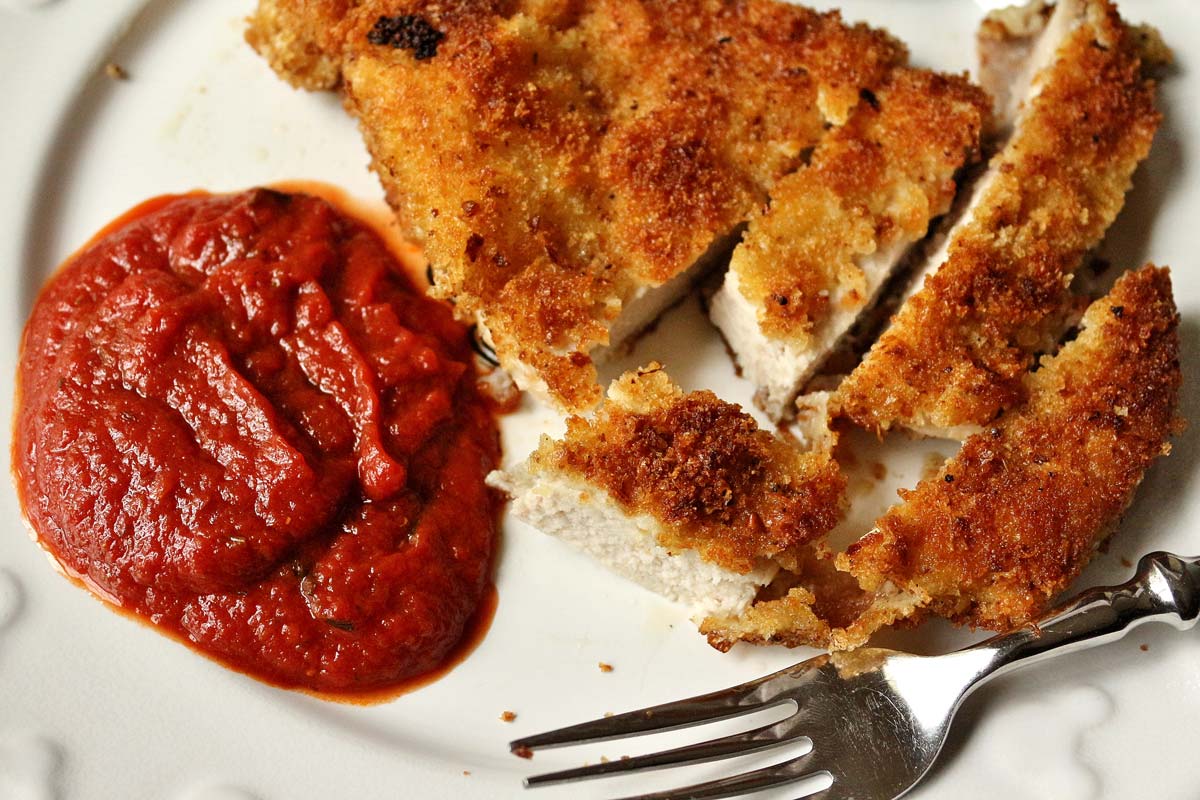Revitalize your pork chop game with this outstanding recipe for Milanese Pork with Tomato-Balsamic Sauce! It's crispy, juicy, and packed with flavor. The extra sauce is great for dipping mozzarella sticks, topping pizza, and even tossing with pasta.

How do you boost the flavor and juiciness of pork chops (other than not overcooking them)? Brine your pork in a simple orange-infused brine, bread it with a mixture of well-seasoned breadcrumbs and panko, and cook it to a crisp in a hot skillet!
Chicken and steak are both common proteins used for a Milanese preparation, but these pounded-thin pork chops are an excellent alternative. Served with a balsamic and lemon-infused tomato sauce laced with a bit of heat, this brined pork chop Milanese is beautiful way to serve pork without drying it out.
How to make it
Make the brine by combining water, sugar, salt, and orange zest in a medium saucepan. Bring to a boil and stir to dissolve the sugar and salt. Transfer to a medium heatproof bowl, and stir in ice water.
Meanwhile, one at a time, place a pork chop between two sheets of plastic wrap and pound with a meat pounder until it is about ⅓-inch thick. Put the pork in a 1-gallon zippered plastic bag and pour in the brine. Seal the bag tightly, place in a bowl, and refrigerate for at least 1 hour or up to 2 hours, no longer or it will get too salty.
Next, make the sauce. Heat oil and garlic together until the garlic is toasted to golden brown, about 2 minutes. Using a slotted spoon, remove and discard the garlic.
Stir hot pepper flakes into the oil. Stir in canned tomatoes with their juices and lemon zest. Bring to a boil, then reduce the heat to low and simmer about 1 hour. Stir in basil, oregano, balsamic vinegar, and sugar.
Remove the pork from the marinade and pat it dry with paper towels. Spread the flour in a wide shallow bowl. Beat eggs, salt, and pepper together in a second shallow bowl. Then, mix breadcrumbs, panko, parsley, lemon zest, and hot pepper flakes in a third bowl.
To bread the pork chops, one at a time, coat the pork in the flour, shaking off the excess, then dip on both sides in the egg mixture and coat evenly with the panko mixture, patting it in gently to adhere. Transfer to a platter. Let the pork stand for about 10 minutes to set the coating.
Line a large baking sheet with paper towels. Pour enough oil into a very large preferably non-stick skillet to come ¼-inch (or slightly less) up the sides and heat over medium-high heat until shimmering.
Add the pork to the oil and cook, adjusting the heat so the pork bubbles steadily in the oil without browning too quickly, until the underside is golden brown, about 3 minutes. Turn the pork over and brown the other side, about 3 minutes more.
Transfer Milanese pork to the paper towels and drain briefly. Cut each pork chop crosswise into ½-inch strips, or serve them whole. Transfer Milanese pork chops to a platter and serve immediately with the sauce on the side.
Please scroll to the bottom of the post for the full recipe (in a printable recipe card) including ingredient amounts and detailed instructions.

Expert tips
There is a misconception that pork needs to be super well-done in order to be safe to eat. This simply isn't true. Pork is technically safe to eat at an internal temperature of 145°F. Don't overcook your pork chops Milanese and they won't dry out.
You will likely still have extra sauce even with 4 servings of Milanese pork. The leftover sauce would work well on pizza and even pasta. You can also use it as a dipping sauce for mozzarella sticks or my chicken parmesan dumplings! My sauce was reminiscent of a silky marinara, smoother than if I had used canned plum tomatoes, but either texture is fine depending on your preference.

Other recipes you may like
- Jägerschnitzel (Schnitzel with Mushroom Gravy)
- Mojo Pork with Black Beans
- Pork Lo Mein
- Thomas Keller's Brined Pork Tenderloin
- Barceloneta Potato Bombas
- Crab Stuffed Shells with Orange-Scented Tomato Sauce
- Spaghetti with Cod, Broccoli Rabe, and Garlic
Tried this recipe? Please leave a star ⭐️⭐️⭐️⭐️⭐️ rating in the recipe card below and/or a review in the comments section further down the page. You can also follow me on social media on Facebook, Instagram, and Pinterest!

Milanese Pork with Tomato-Balsamic Sauce
Ingredients
Brine and Pork Chops:
- 2 cups water
- ⅓ cup plus 1 tablespoon sugar
- ¼ cup kosher salt
- Zest strips of ½ large orange removed with a vegetable peeler
- 1 ½ quarts ice water
- 4 (8 ounce) boneless pork chops
Tomato-Balsamic Sauce:
- 2 tablespoons extra-virgin olive oil
- 2 garlic cloves crushed under a knife and peeled
- ½ teaspoon hot red pepper flakes
- 1 (28-ounce) can plum tomatoes, coarsely crushed by hand (you can also use a can of tomato passata/puree or crushed tomatoes)
- Finely grated zest of 1 lemon
- ⅓ cup coarsely chopped fresh basil
- 1 tablespoon finely chopped fresh oregano or ½ tablespoon dried oregano
- 1 tablespoon balsamic vinegar preferably aged balsamic
- 1 teaspoon sugar
Coating:
- ½ cup unbleached all-purpose flour
- 2 large eggs
- ½ teaspoon kosher salt
- ½ teaspoon freshly ground black pepper
- ½ cup dried breadcrumbs
- ½ cup panko Japanese breadcrumbs
- 2 tablespoons finely chopped fresh parsley
- Grated zest of 1 lemon
- ¼ teaspoon crushed hot red pepper flakes
- Vegetable oil for frying
Instructions
- To brine the chops: Combine the water, sugar, salt, and orange zest in a medium saucepan. Bring to a boil over high heat, stirring often to dissolve the sugar and salt. Transfer to a medium heatproof bowl, and stir in the ice water–the brine must be very cold.
- Meanwhile, one at a time, place a pork chop between two sheets of plastic wrap. Pound the chop with the flat side of a meat pounder until it is about ⅓-inch thick. Put the pork in a 1-gallon zippered plastic bag and pour in the brine. Seal the bag tightly, place in a bowl, and refrigerate for at least 1 hour or up to 2 hours, no longer.
- Meanwhile, make the sauce: Heat the oil and garlic together in a medium saucepan over medium heat until the garlic is toasted to golden brown, about 2 minutes. Using a slotted spoon, remove and discard the garlic. Stir the hot pepper flakes into the oil. Stir in the tomatoes with their juices and the lemon zest. Bring to a boil. Reduce the heat to low and simmer, stirring occasionally, until slightly reduced, about 1 hour. During the last few minutes stir in the basil, oregano, balsamic vinegar, and sugar. Season to taste with salt as needed. The sauce can be cooled, covered, and refrigerated for up to 3 days. Reheat before serving.
- To coat the pork chops: Remove the pork from the marinade and pat it dry with paper towels. Spread the flour in a wide shallow bowl. Beat the eggs, salt, and pepper together in a second shallow bowl. Mix the breadcrumbs, panko, parsley, lemon zest, and hot pepper flakes in a third bowl. One at a time, coat the pork in the flour, shaking off the excess, then dip on both sides in the egg mixture and coat evenly with the panko mixture, patting it in gently to adhere. Transfer to a platter. Let the pork stand for about 10 minutes to set the coating.
- To cook: Line a large baking sheet with paper towels. Pour enough oil into a very large preferably non-stick skillet to come ¼-inch (I used less) up the sides and heat over medium-high heat until shimmering. Add the pork to the oil and cook, adjusting the heat so the pork bubbles steadily in the oil without browning too quickly, until the underside is golden brown, about 3 minutes. Turn the pork over and brown the other side, about 3 minutes more. Transfer to the paper towels and drain briefly. Cut each pork chop crosswise into ½-inch strips (or serve them whole as I did). Transfer to a platter and serve immediately, with the tomato sauce on the side.
Notes
- There is a misconception that pork needs to be super well-done in order to be safe to eat. This simply isn't true. Pork is technically safe to eat at an internal temperature of 145°F.
- You will likely still have extra sauce even with 4 servings of Milanese pork. The leftover sauce would work well on pizza and even pasta. You can also use it as a dipping sauce for mozzarella sticks or my chicken parmesan dumplings! My sauce was reminiscent of a silky marinara, smoother than if I had used canned plum tomatoes, but either texture is fine depending on your preference.
- This recipe uses kosher salt (aka cooking salt, kitchen salt, coarse salt outside of the US). If you are using table salt, definitely scale down the salt as that is a saltier type of salt! The type of salt will make a big difference in how salty your food tastes, so keep that in mind.
- Adapted from Share
Nutrition
*All nutritional information is based on third-party calculations and should be considered estimates. Actual nutritional content will vary with brands used, measuring methods, portion sizes and more.*










Comments
No Comments